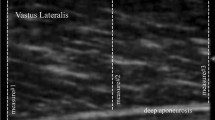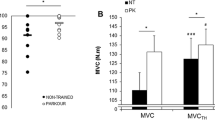Abstract
This study compared neural profiles of the leg muscles of volleyball athletes playing in different divisions of Taiwan’s national league to analyse the reliability and correlations between their profiles and biomechanical performances. Twenty-nine athletes including 12 and 17 from the first and second divisions of the league, respectively, were recruited. The outcome measures were compared between the divisions, including soleus H-reflex, first volitional (V) wave, normalised rate of electromyography (EMG) rise (RER) in the triceps surae muscles, and RER ratio for the tibialis anterior and soleus muscles, normalised root mean square (RMS) EMG in the triceps surae muscles, antagonist co-activation of the tibialis anterior muscle, rate of force development (RFD), and maximal plantar flexion torque and jump height. Compared to the results of the second division, the neural profiles of the first division showed greater normalised V waves, normalised RER in the lateral gastrocnemius, and normalised RMS EMG of the soleus and lateral gastrocnemius muscles with less antagonist co-activation of the tibialis anterior. First division volleyball athletes showed greater maximal torque, jump height, absolute RFD at 0–30, 0–100, and 0–200 ms, and less in the normalised RFD at 0–200 ms of plantar flexion when compared to the results of those in the second division. Neural profiles correlated to fast or maximal muscle strength or jump height. There are differences in the descending neural drive and activation strategies in leg muscles during contractions between volleyball athletes competing at different levels. These measures are reliable and correlate to biomechanical performances.





Similar content being viewed by others
References
Aagaard P (2003) Training-induced changes in neural function. Exerc Sport Sci Rev 31:61–67
Aagaard P, Simonsen EB, Andersen JL, Magnusson P, Dyhre-Poulsen P (2002a) Neural adaptation to resistance training: changes in evoked V-wave and H-reflex responses. J Appl Physiol 92:2309–2318
Aagaard P, Simonsen EB, Andersen JL, Magnusson P, Dyhre-Poulsen P (2002b) Increased rate of force development and neural drive of human skeletal muscle following resistance training. J Appl Physiol 93:1318–1326
Barry BK, Warman GE, Carson RG (2005) Age-related differences in rapid muscle activation after rate of force development training of the elbow flexors. Exp Brain Res 162:122–132. doi:10.1007/s00221-004-2127-3
Basmajian JV (1977) Motor learning and control: a working hypothesis. Arch Phys Med Rehabil 58:38–41
Blazevich AJ, Cannavan D, Horne S, Coleman DR, Aagaard P (2009) Changes in muscle force-length properties affect the early rise of force in vivo. Muscle Nerve 39:512–520. doi:10.1002/mus.21259
Bojsen-Møller J, Magnusson SP, Rasmussen LR, Kjaer M, Aagaard P (2005) Muscle performance during maximal isometric and dynamic contractions is influenced by the stiffness of the tendinous structures. J Appl Physiol 99:986–994. doi:10.1152/japplphysiol.01305.2004
Cannon J, Kay D, Tarpenning KM, Marino FE (2007) Comparative effects of resistance training on peak isometric torque, muscle hypertrophy, voluntary activation and surface EMG between young and elderly women. Clin Physiol Funct Imaging 27:91–100. doi:10.1111/j.1475-097X.2007.00719.x
Chapman AR, Vicenzino B, Blanch P, Hodges PW (2008) Patterns of leg muscle recruitment vary between novice and highly trained cyclists. J Electromyogr Kinesiol 18(3):359–371. doi:10.1016/j.jelekin.2005.12.007
Chimera NJ, Swanik KA, Swanik CB, Straub SJ (2004) Effects of plyometric training on muscle-activation strategies and performance in female athletes. J Athl Train 39:24–31
Del Balso C, Cafarelli E (2007) Adaptations in the activation of human skeletal muscle induced by short-term isometric resistance training. J Appl Physiol 103:402–411. doi:10.1152/japplphysiol.00477.2006
Duclay J, Martin A (2005) Evoked H-reflex and V-wave responses during maximal isometric, concentric, and eccentric muscle contraction. J Neurophysiol 94:3555–3562. doi:10.1152/jn.00348.2005
Ekblom MM (2010) Improvements in dynamic plantar flexor strength after resistance training are associated with increased voluntary activation and V-to-M ratio. J Appl Physiol 109:19–26. doi:10.1152/japplphysiol.01307.2009
Gondin J, Duclay J, Martin A (2006) Soleus- and Gastrocnemii-evoked V wave responses increase after neuromuscular electrical stimulation training. J Neurophysiol 95:3328–3335. doi:10.1152/jn.01002.2005
Gruber M, Gollhofer A (2004) Impact of sensorimotor training on the rate of force development and neural activation. Eur J Appl Physiol 92:98–105. doi:10.1007/s00421-004-1080-y
Hagood S, Solomonow M, Baratta R, Zhou BH, D’Ambrosia R (1990) The effect of joint velocity on the contribution of the antagonist musculature to knee stiffness and laxity. Am J Sports Med 18:182–187
Harridge SD, Bottinelli R, Canepari M, Pellegrino MA, Reggiani C, Esbjörnsson M, Saltin B (1996) Whole-muscle and single-fibre contractile properties and myosin heavy chain isoforms in humans. Pflugers Arch 432:913–920
Holtermann A, Roeleveld K, Engstrøm M, Sand T (2007) Enhanced H-reflex with resistance training is related to increased rate of force development. Eur J Appl Physiol 101:301–312. doi:10.1007/s00421-007-0503-y
Jubeau M, Zory R, Gondin J, Martin A, Maffiuletti NA (2006) Late neural adaptations to electrostimulation resistance training of the plantar flexor muscles. Eur J Appl Physiol 98:202–211. doi:10.1007/s00421-006-0264-z
Kawakami Y, Ichinose Y, Fukunaga T (1998) Architectural and functional features of human triceps surae muscles during contraction. J Appl Physiol 85:398–404
Lepers R, Millet GY, Maffiuletti NA (2001) Effect of cycling cadence on contractile and neural properties of knee extensors. Med Sci Sports Exerc 33:1882–1888
Lévénez M, Garland SJ, Klass M, Duchateau J (2008) Cortical and spinal modulation of antagonist coactivation during a submaximal fatiguing contraction in humans. J Neurophysiol 99:554–563. doi:10.1152/jn.00963.2007
Maffiuletti NA, Pensini M, Martin A (2002) Activation of human plantar flexor muscles increases after electromyostimulation training. J Appl Physiol 92:1383–1392
Masci I, Vannozzi G, Gizzi L, Bellotti P, Felici F (2010) Neuromechanical evidence of improved neuromuscular control around knee joint in volleyball players. Eur J Appl Physiol 108:443–450
Reeves ND, Narici MV, Maganaris CN (2003) Strength training alters the viscoelastic properties of tendons in elderly humans. Muscle Nerve 28:74–81
Ricard MD, Ugrinowitsch C, Parcell AC, Hilton S, Rubley MD, Sawyer R, Poole CR (2005) Effects of rate of force development on EMG amplitude and frequency. Int J Sports Med 26:66–70. doi:10.1055/s-2004-817856
Solstad GM, Fimland MS, Helgerud J, Iversen VM, Hoff J (2011) Test-retest reliability of v-wave responses in the soleus and gastrocnemius medialis. J Clin Neurophysiol 28:217–221. doi:10.1097/WNP.0b013e31821215cf
Tillin NA, Jimenez-Reyes P, Pain MT, Folland JP (2010) Neuromuscular performance of explosive power athletes versus untrained individuals. Med Sci Sports Exerc 42:781–790. doi:10.1249/MSS.0b013e3181be9c7e
Wang HK, Lin KH, Wu YK, Chi SC, Shih TT, Huang YC (2011) Evoked spinal reflexes and force development in elite athletes with middle portion Achilles tendinopathy. J Orthop Sports Phys Ther 41:785–794. doi:10.2519/jospt.2011.3564
Wickiewicz TL, Roy RR, Powell PL, Edgerton VR (1983) Muscle architecture of the human lower limb. Clin Orthop 179:275–283
Wu YK, Lien YH, Lin KH, Shih TT, Wang TG, Wang HK (2010) Relationships between three potentiation effects of plyometric training and performance. Scand J Med Sci Sports 20:e80–e86. doi:10.1111/j.1600-0838.2009.00908.x
Author information
Authors and Affiliations
Corresponding author
Additional information
Communicated by Alain Martin.
Rights and permissions
About this article
Cite this article
Un, CP., Lin, KH., Shiang, TY. et al. Comparative and reliability studies of neuromechanical leg muscle performances of volleyball athletes in different divisions. Eur J Appl Physiol 113, 457–466 (2013). https://doi.org/10.1007/s00421-012-2454-1
Received:
Accepted:
Published:
Issue Date:
DOI: https://doi.org/10.1007/s00421-012-2454-1




